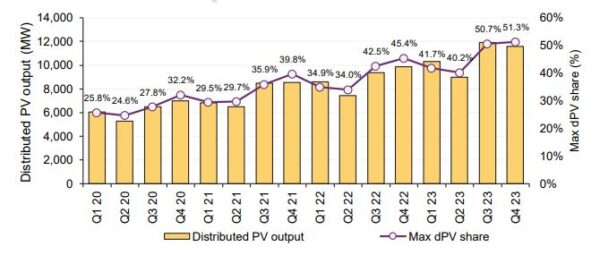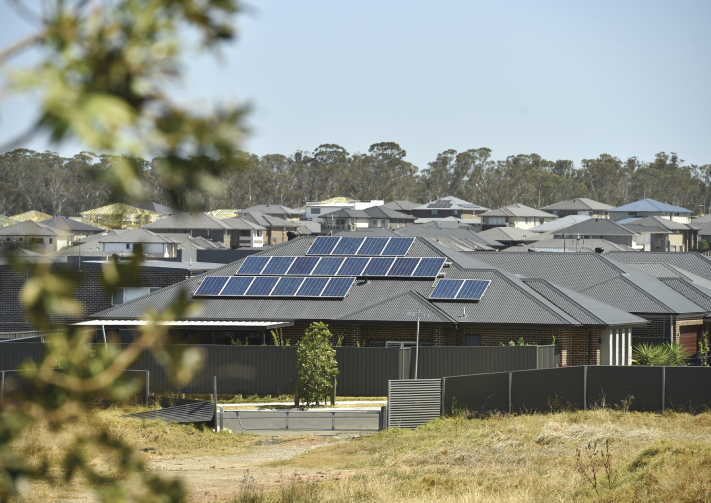The Australian Energy Market Operator’s (AEMO) latest Quarterly Energy Dynamics report shows that new records are rapidly being set for the amount of renewable energy, including grid-scale and rooftop solar, being fed into the National Electricity Market (NEM), reducing the reliance on traditional coal-fired generation.
AEMO Chief Executive Officer Daniel Westerman said there were moments in time in the final three months of 2023 that show just how fast Australia’s energy transition is happening.
“Early in the afternoon of 31 December rooftop solar met 101% of South Australia’s total electricity demand,” he said. “While on the afternoon of 24 October rooftop solar and grid-scale renewables provided 72% of all electricity across the east coast.”
“These events are snapshots of the transition that’s happening, and they are becoming more frequent. We are regularly seeing records set for the higher contribution of renewables, and lower levels of energy drawn from the grid because of rooftop solar.”
The latest Quarterly Energy Dynamics report shows that average distributed PV output reached an all-time high in Q4 2023 of 3,433 MW, 505 MW or 17% higher than the same period in 2022 and a new record for any quarter.
The market operator said distributed PV output reached record highs in all regions, with October yielding a particularly notable 44% year-on-year increase in monthly average for the NEM. By contrast, the NEM-wide November average rose only 7% year-on-year, with New South Wales (NSW) and Queensland experiencing decreases on 2022 levels.
In December, this position reversed, with monthly averages falling in Victoria and South Australia within a 7% NEM-wide increase. At 17% for Q4 as a whole, year-on-year growth of distributed PV output was lower than in recent quarters which had recorded annual growth rates of about 30%.
By region, New South Wales (NSW) experienced a 20% increase in distributed PV output, reaching a quarterly average of 1,155 MW, while Queensland saw an 18% rise to average 1,063 MW.

Image: AEMO
Maximum instantaneous distributed PV share of underlying demand across the NEM reached a record high of 51.3% at 1.30pm on 29 October 2023. At the time, distributed PV output reached 11,583 MW while the underlying demand was at 22,592 MW. This was 0.6 percentage points higher than the previous record of 50.7% set on 30 September 2023.
The increase in distributed PV output was accompanied by increasing grid-scale renewable output and a new record for maximum instantaneous share of renewable energy generation of 72.1% was reached during the half-hour ending 1pm on 24 October 2023.
Grid-scale variable renewable energy output reached an all-time quarterly average record high of 5,168 MW, 14% higher than the corresponding period in 2022.
AEMO said the increase was predominantly driven by new and recently commissioned units in NSW and Queensland lifting NEM average grid-scale solar output to a record high of 2,021 MW, up 23% from Q4 2022.
At the end of Q4 2023, new capacity totalling 36 GW was progressing through the connection process from application to commissioning. During Q4 2023, AEMO approved applications for 6.5 GW of capacity across 28 projects, a notable increase from 1.7 GW across 11 projects in Q4 2022.
With continued year-on-year increases in battery capacity, average generation from the NEM battery fleet increased 21 MW to reach 47 MW in the last quarter of 2023.
While the share of renewables rose to new highs, average NEM black coal-fired generation fell to a new quarterly low of 9,189 MW. Gas-fired generation fell by 55 MW, mainly in South Australia and Victoria, while hydro output was down 219 MW driven by lower output in Tasmania and Victoria.
The increase in renewable output also drove NEM total emissions and emissions intensity to record low levels of 25.4 million tonnes of carbon dioxide equivalents (MtCO2-e) and 0.59 tCO2-e/MWh respectively.
This content is protected by copyright and may not be reused. If you want to cooperate with us and would like to reuse some of our content, please contact: editors@pv-magazine.com.









7 comments
By submitting this form you agree to pv magazine using your data for the purposes of publishing your comment.
Your personal data will only be disclosed or otherwise transmitted to third parties for the purposes of spam filtering or if this is necessary for technical maintenance of the website. Any other transfer to third parties will not take place unless this is justified on the basis of applicable data protection regulations or if pv magazine is legally obliged to do so.
You may revoke this consent at any time with effect for the future, in which case your personal data will be deleted immediately. Otherwise, your data will be deleted if pv magazine has processed your request or the purpose of data storage is fulfilled.
Further information on data privacy can be found in our Data Protection Policy.